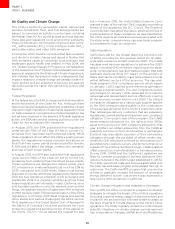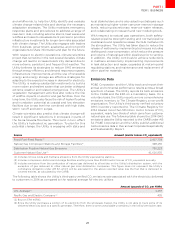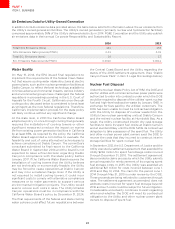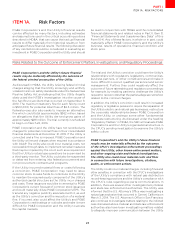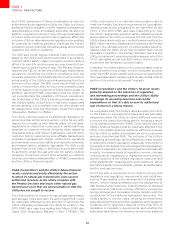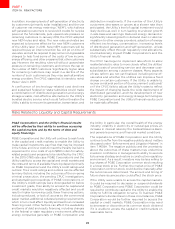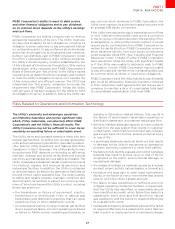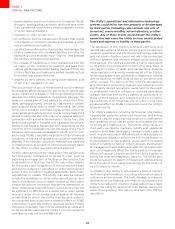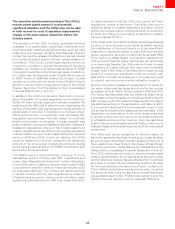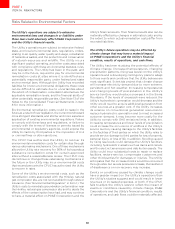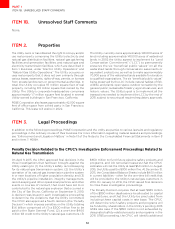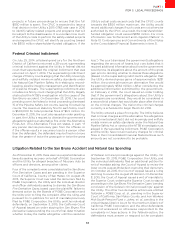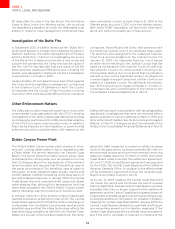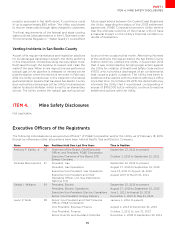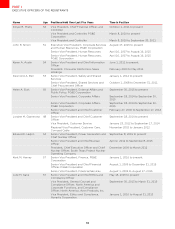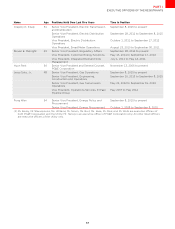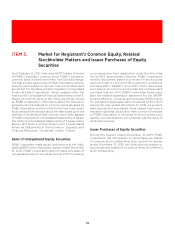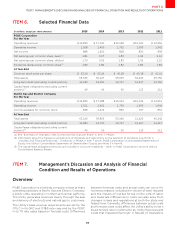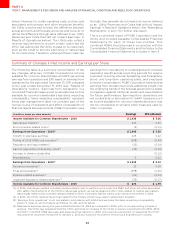PG&E 2015 Annual Report Download - page 38
Download and view the complete annual report
Please find page 38 of the 2015 PG&E annual report below. You can navigate through the pages in the report by either clicking on the pages listed below, or by using the keyword search tool below to find specific information within the annual report.
30
PART I
ITEM 1A.RISK FACTORS
Risks Related to Environmental Factors
The Utility’s operations are subject to extensive
environmental laws and changes in or liabilities under
these laws could adversely aect PG&E Corporation’s
and the Utility’s financial results.
The Utility’s operations are subject to extensive federal,
state, and local environmental laws, regulations, orders,
relating to air quality, water quality and usage, remediation
of hazardous wastes, and the protection and conservation
of natural resources and wildlife. The Utility incurs
significant capital, operating, and other costs associated
with compliance with these environmental statutes, rules,
and regulations. The Utility has been in the past, and
may be in the future, required to pay for environmental
remediation costs at sites where it is identified as a
potentially responsible party under federal and state
environmental laws. Although the Utility has recorded
liabilities for known environmental obligations, these costs
can be dicult to estimate due to uncertainties about
the extent of contamination, remediation alternatives, the
applicable remediation levels, and the financial ability of
other potentially responsible parties. (See Note 13 of the
Notes to the Consolidated Financial Statements in Item
8 for more information.)
Environmental remediation costs could increase in the
future as a result of new legislation, the current trend toward
more stringent standards, and stricter and more expansive
application of existing environmental regulations. Failure
to comply with these laws and regulations, or failure to
comply with the terms of licenses or permits issued by
environmental or regulatory agencies, could expose the
Utility to claims by third parties or the imposition of civil
or criminal fines or other sanctions.
The CPUC has authorized the Utility to recover its
environmental remediation costs for certain sites through
various ratemaking mechanisms. One of these mechanisms
allows the Utility rate recovery for 90% of its hazardous
substance remediation costs for certain approved
sites without a reasonableness review. The CPUC may
discontinue or change these ratemaking mechanisms in
the future or the Utility may incur environmental costs
that exceed amounts the CPUC has authorized the Utility
to recover in rates.
Some of the Utility’s environmental costs, such as the
remediation costs associated with the Hinkley natural
gas compressor site, are not recoverable through rates or
insurance. (See “Environmental Regulation” in Item 1.) The
Utility’s costs to remediate groundwater contamination near
the Hinkley natural gas compressor site and to abate the
eects of the contamination have had, and may continue
to have, a material eect on PG&E Corporation’s and the
Utility’s financial results. Their financial results also can be
materially aected by changes in estimated costs and by
the extent to which actual remediation costs dier from
recorded liabilities.
The Utility’s future operations may be aected by
climate change that may have a material impact
on PG&E Corporation’s and the Utility’s financial
condition, results of operations, and cash flows.
The Utility has been studying the potential eects of
climate change (increased temperatures, changing
precipitation patterns, rising sea levels) on the Utility’s
operations and is developing contingency plans to adapt
to those events and conditions that the Utility believes are
most significant. Scientists project that climate change
will increase electricity demand due to more extreme,
persistent and hot weather. Increasing temperatures
and changing levels of precipitation in the Utility’s
service territory would reduce snowpack in the Sierra
Mountains. If the levels of snowpack were reduced, the
Utility’s hydroelectric generation would decrease and the
Utility would need to acquire additional generation from
other sources at a greater cost. If the Utility increases
its reliance on conventional generation resources to
replace hydroelectric generation and to meet increased
customer demand, it may become more costly for the
Utility to comply with GHG emissions limits. In addition,
increasing temperatures and lower levels of precipitation
could increase the occurrence of wildfires in the Utility’s
service territory causing damage to the Utility’s facilities
or the facilities of third parties on which the Utility relies to
provide service, damage to third parties for loss of property,
personal injury, or loss of life. In addition, flooding caused
by rising sea levels could damage the Utility’s facilities,
including hydroelectric assets such as dams and canals,
and the electric transmission and distribution assets. The
Utility could incur substantial costs to repair or replace
facilities, restore service, compensate customers and
other third parties for damages or injuries. The Utility
anticipates that the increased costs would be recovered
through rates, but as rate pressures increase, the likelihood
of disallowance or non-recovery may increase.
Events or conditions caused by climate change could
have a greater impact on the Utility’s operations than
the Utility’s studies suggest and could result in lower
revenues or increased expenses, or both. If the CPUC
fails to adjust the Utility’s rates to reflect the impact of
events or conditions caused by climate change, PG&E
Corporation’s and the Utility’s financial condition, results
of operations, and cash flows could be materially aected.


